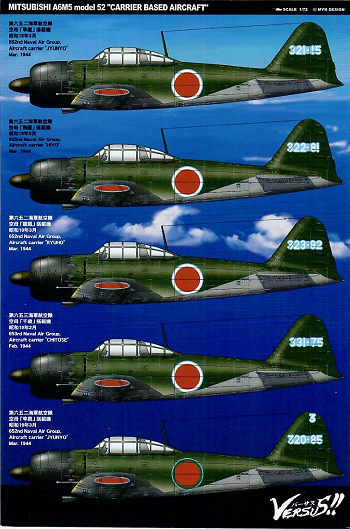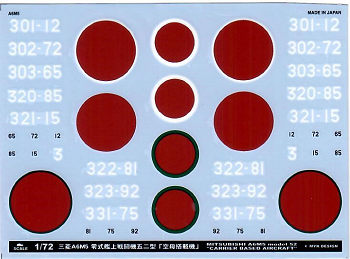MYK Design 72065: A6M5 'Carrier Based Aircraft'
|
SHEET #: |
72065 |
|
PRICE: |
800 yen
|
|
REVIEWER: |
Tom
Hall |
 MYK Design
is a company in Hiroshima. The first two initials are those of the owner. I
recently discovered a few of their 1/72 scale sheets on eBay and ordered two.
The package that arrived included a long list of their products, all written in
Japanese (which I can read). Over half of their offerings are for 1/144
aircraft!
MYK Design
is a company in Hiroshima. The first two initials are those of the owner. I
recently discovered a few of their 1/72 scale sheets on eBay and ordered two.
The package that arrived included a long list of their products, all written in
Japanese (which I can read). Over half of their offerings are for 1/144
aircraft!
I have not
wetted any of their decals and do not know how they perform.
This sheet
includes both white numerals for tail markings and black numerals for landing
gear doors. Time will tell whether the white ink turns yellow. Unfortunately,
there arent any tiny white numerals for the front of the cowling. The numerals
are good facsimiles of wartime markings.
This sheet
throws the modeler into the deep end of carrier plane tail markings for the
first half of 1944. The few photos that have been published show something less
than a consistent scheme. Although it is tempting to think that a Japanese decal
maker may have special insight into the matter, MYK has not provided any written
support for its choices, and I suspect that at least half are speculative. Mr.
M. Y. does not identify the one unit denoted by codes 301, 302 and 303,
which are among those provided. (He may believe them to be for Number 601 Kaigun
Kōkūtai for some part of the period February 1944-June 1944. However, a Japanese
reference tells us that codes for that unit were 311, 312 and 313.)
 One set of markings is basically a
re-pop of what is in the Tamiya 1/72 plain Model Five Two kit: 3 over 320-85. A
photo of 3 over 320-85 (all numerals apparently in white, and the 3s are
flattop) was published in 2005 in Tatakau
Umiwashi ― Taiintachi
no Shashinshū by Yōji
Watanabe. It shows a Model 52 on the deck of Junyō.
The photo came as a surprise to Japanese naval aircraft buffs. The 0 is
apparently a refusal to identify a mother ship. The aircraft unit is Number 652
Kaigun Kōkūtai, which was intended, at times, to be based on three carriers
simultaneously, Junyō, Hiyō
and Ryūhō. The 0
unit code may have been a sort of wild card suitable for all three carriers.
(Number 652 Kaigun Kōkūtai was a large composite unit that was established on
paper on 10 March 1944. At first, it was land-based and terribly under-strength
as to aircraft inventory and training. The plan was that it would move onto the
three aircraft carriers when enough aircraft were delivered and enough pilots
were checked out for carrier landings. It was placed into Number 2 Kōkū Sentai,
as indicated by the 2 in 320. Suffering heavy losses in the Battle of the
Philippine Sea, it was disbanded on 10 July 1944. The fate of 3 over 320-85 is
unclear. My theory is that it was not necessarily closely associated with
Junyō. It may have been one of a small
number of fighters held in reserve by the kōkūtai, and possibly not counted as
part of any particular carriers complement.)
One set of markings is basically a
re-pop of what is in the Tamiya 1/72 plain Model Five Two kit: 3 over 320-85. A
photo of 3 over 320-85 (all numerals apparently in white, and the 3s are
flattop) was published in 2005 in Tatakau
Umiwashi ― Taiintachi
no Shashinshū by Yōji
Watanabe. It shows a Model 52 on the deck of Junyō.
The photo came as a surprise to Japanese naval aircraft buffs. The 0 is
apparently a refusal to identify a mother ship. The aircraft unit is Number 652
Kaigun Kōkūtai, which was intended, at times, to be based on three carriers
simultaneously, Junyō, Hiyō
and Ryūhō. The 0
unit code may have been a sort of wild card suitable for all three carriers.
(Number 652 Kaigun Kōkūtai was a large composite unit that was established on
paper on 10 March 1944. At first, it was land-based and terribly under-strength
as to aircraft inventory and training. The plan was that it would move onto the
three aircraft carriers when enough aircraft were delivered and enough pilots
were checked out for carrier landings. It was placed into Number 2 Kōkū Sentai,
as indicated by the 2 in 320. Suffering heavy losses in the Battle of the
Philippine Sea, it was disbanded on 10 July 1944. The fate of 3 over 320-85 is
unclear. My theory is that it was not necessarily closely associated with
Junyō. It may have been one of a small
number of fighters held in reserve by the kōkūtai, and possibly not counted as
part of any particular carriers complement.)
On the
same sheet MYK has rendered 321-15 as another Junyō
plane for exactly the same month in which it places 3 over 320-85, March 1944!
This is the sort of thing that confuses modelers. It is conceivable that both 3
over 320-85 and 321-15 were contemporaneous and associated with
Junyō in some way,
but MYK does not give any guidance.
Another surprise
from the photo of 3 over 320-85 was the use of the single digit above the unit
code and airplane number. It was not a common practice in 1944 and should not be
extrapolated to many other models. (Incidentally, a high airplane number like 85
may have been assigned for planes on the third carrier of Number 2 Kōkū Sentai,
Ryūhō, even though the photo was taken
on Junyō. Junyōs flight deck was
approximately 80 feet longer than Ryūhōs
at the time and may have been deemed more suitable for training.)
Oddly, MYK
has chosen to use flattop 3s only for the one plane; the seven other tail
markings have round-top 3s. In the first half of 1944, the round-top 3 was not
so predominant. Also, MYKs color choice of white tends to place these tail
markings in the first quarter of 1944 or earlier, making them largely useless
for the Battle of the Philippine Sea. For that battle, carrier plane tail codes
were yellow.
The
sheet includes hinomaru for one plane,
with a few extra disks. In my next review here, I will comment on the dark red
ink that MYK has chosen for hinomaru.
IJN Ryūhō:
Tabular Record of Movement, Anthony Tully, 2001, www.combinedfleet.com.
Japanese
Naval Air Force
Camouflage and
Markings World War
II, Donald W. Thorpe, Aero Publishers, Inc.,
1977.
Japanese
Naval Air Force
Fighter Units and
Their Aces
1932-1945, Ikuhiko Hata, Yasuho Izawa and Christopher
Shores, Grub Street, 2011.
Sekai
no Kessaku Ki
(aka Famous Airplanes of the World) No. 9, Bunrindō, 1988, 1993 reprint.
Tatakau
Umiwashi ― Taiintachi
no Shashinshū, Yōji
Watanabe, Bungeishunjū (2005).
Warships of
the Imperial Japanese
Navy, 1869-1945,
Hansgeorg Jentschura, Dieter Jung and Peter Mickel, U.S. Naval Institute, 1982.
Tom Hall
April 2018
Copyright ModelingMadness.com
If you would like your product reviewed fairly and fairly quickly, please
contact
the editor or see other details in the
Note to
Contributors.
 MYK Design
is a company in Hiroshima. The first two initials are those of the owner. I
recently discovered a few of their 1/72 scale sheets on eBay and ordered two.
The package that arrived included a long list of their products, all written in
Japanese (which I can read). Over half of their offerings are for 1/144
aircraft!
MYK Design
is a company in Hiroshima. The first two initials are those of the owner. I
recently discovered a few of their 1/72 scale sheets on eBay and ordered two.
The package that arrived included a long list of their products, all written in
Japanese (which I can read). Over half of their offerings are for 1/144
aircraft!  One set of markings is basically a
re-pop of what is in the Tamiya 1/72 plain Model Five Two kit: 3 over 320-85. A
photo of 3 over 320-85 (all numerals apparently in white, and the 3s are
flattop) was published in 2005 in Tatakau
Umiwashi ― Taiintachi
no Shashinshū by Yōji
Watanabe. It shows a Model 52 on the deck of Junyō.
The photo came as a surprise to Japanese naval aircraft buffs. The 0 is
apparently a refusal to identify a mother ship. The aircraft unit is Number 652
Kaigun Kōkūtai, which was intended, at times, to be based on three carriers
simultaneously, Junyō, Hiyō
and Ryūhō. The 0
unit code may have been a sort of wild card suitable for all three carriers.
(Number 652 Kaigun Kōkūtai was a large composite unit that was established on
paper on 10 March 1944. At first, it was land-based and terribly under-strength
as to aircraft inventory and training. The plan was that it would move onto the
three aircraft carriers when enough aircraft were delivered and enough pilots
were checked out for carrier landings. It was placed into Number 2 Kōkū Sentai,
as indicated by the 2 in 320. Suffering heavy losses in the Battle of the
Philippine Sea, it was disbanded on 10 July 1944. The fate of 3 over 320-85 is
unclear. My theory is that it was not necessarily closely associated with
Junyō. It may have been one of a small
number of fighters held in reserve by the kōkūtai, and possibly not counted as
part of any particular carriers complement.)
One set of markings is basically a
re-pop of what is in the Tamiya 1/72 plain Model Five Two kit: 3 over 320-85. A
photo of 3 over 320-85 (all numerals apparently in white, and the 3s are
flattop) was published in 2005 in Tatakau
Umiwashi ― Taiintachi
no Shashinshū by Yōji
Watanabe. It shows a Model 52 on the deck of Junyō.
The photo came as a surprise to Japanese naval aircraft buffs. The 0 is
apparently a refusal to identify a mother ship. The aircraft unit is Number 652
Kaigun Kōkūtai, which was intended, at times, to be based on three carriers
simultaneously, Junyō, Hiyō
and Ryūhō. The 0
unit code may have been a sort of wild card suitable for all three carriers.
(Number 652 Kaigun Kōkūtai was a large composite unit that was established on
paper on 10 March 1944. At first, it was land-based and terribly under-strength
as to aircraft inventory and training. The plan was that it would move onto the
three aircraft carriers when enough aircraft were delivered and enough pilots
were checked out for carrier landings. It was placed into Number 2 Kōkū Sentai,
as indicated by the 2 in 320. Suffering heavy losses in the Battle of the
Philippine Sea, it was disbanded on 10 July 1944. The fate of 3 over 320-85 is
unclear. My theory is that it was not necessarily closely associated with
Junyō. It may have been one of a small
number of fighters held in reserve by the kōkūtai, and possibly not counted as
part of any particular carriers complement.)